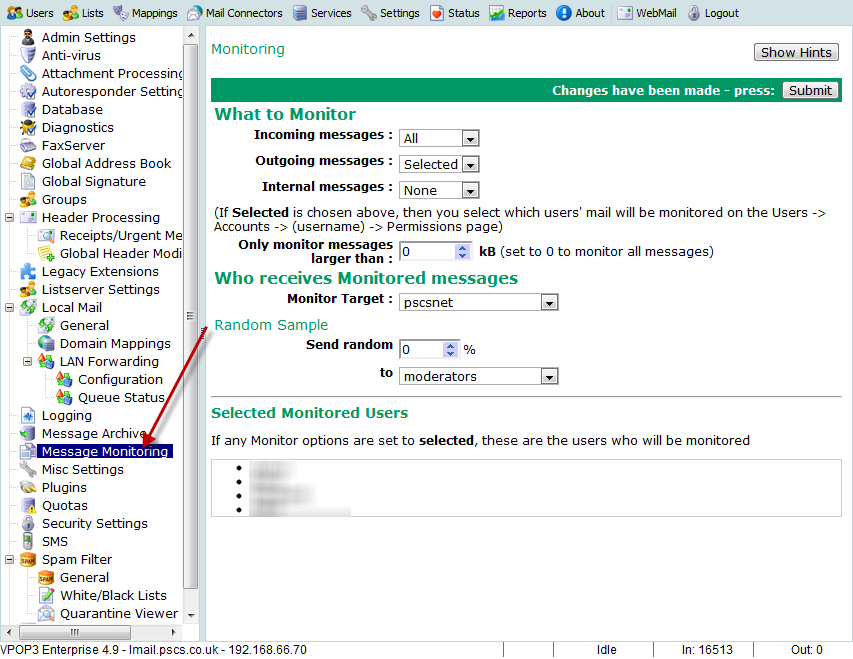Sidebar
Table of Contents
Message Monitoring
Message monitoring in VPOP3 will tell VPOP3 to send a copy of all the outgoing, internal and/or incoming mail from/to specified users to be sent to another specified user.
In the current versions of VPOP3, all monitored messages are sent to the same user (or list), you cannot specify different recipients for different monitored users. (This may be something that is added/enhanced in the future)
How to enable monitoring
To enable Message Monitoring, go to Settings → Message Monitoring in the VPOP3 settings

On this page, choose the desired options from the Incoming messages, Outgoing messages and Internal Messages boxes at the top of the page.
Each option has three choices: All, Selected or None. All will monitor all users, Selected will monitor all users who have the Monitor box checked in the Permissions tab on their settings, and None will not monitor any users.
You can also set a minimum message size for the monitored messages. This may be useful if you just want to check whether someone is sending attachments - eg you could set it to 10 kB to only monitor messages over 10kB (including the attachment), so it will skip smaller messages which are unlikely to contain attached files.
You can then choose who will receive the monitored messages. The Monitor Target will receive all monitored messages. This can be a User or a List
Some people asked for a random sample of messages to be sent to them, rather than all the messages. If you wish to use this facility, then you can put a non-zero value into the Send random X % box, and specify the recipient for the random sample of messages.
At the bottom of the page is a list of all the users who have got Monitor Messages checked in the Permissions tab of their settings, so you can see, at a glance, whose messages will be monitored if you choose Selected as one of the monitoring options.
Monitored Messages
When a message is monitored, it will be copied to the appropriate monitor target's. During the copying, certain header fields are stripped out, such as those requesting a read receipt.
Also, the Subject line is modified so that text beginning with '{Mon-' is prepended to it, to make it easier to see that the message is a monitor copy of a message, rather than a message originally intended for this person. Also, there are some header lines starting with 'X-Monitor-Recipient' or 'X-Monitor-Recipients' added to the message header showing who the message was originally intended for. This can be useful when monitoring outgoing messages, because if the message was BCCd to anyone, that recipient will not be visible in the normal message header, but will be in the 'X-Monitor-Recipients' header line.
(If you wish, you can change the subject prefix in Settings → VPOP3 Text Strings (choose Monitoring in the category list) )
SMTP Authentication
We strongly recommend that you use SMTP authentication if you use Message Monitoring for monitoring outgoing or internal messages. If you use SMTP authentication, then VPOP3 will know exactly who has sent a message (assuming their password has not been compromised). If you don't use SMTP authentication, then VPOP3 has to guess who has sent the message based on the sender's email address - but it is simple for the sender to change their email address in their email client's settings.
